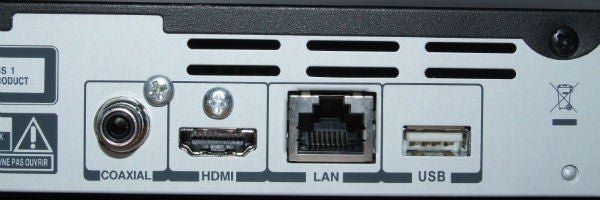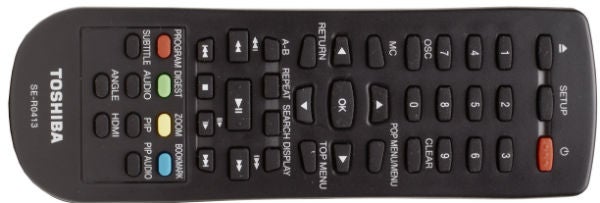Toshiba BDX1250 Review
Toshiba BDX1250
We find out if Toshiba’s latest budget Blu-ray deck can cut it with the big boys…

Verdict
Pros
- Superb pictures
- Easy to use
- Good digital music format support
Cons
- Remote
- Features not commensurate with price
- Few connections
- No DivX support
Key Specifications
- Review Price: £139.99
- BD Live support
- MP3, JPEG, MKV, AVCHD, AAC, WAV, JPEG playback
- USB port
- Dolby True HD & DTS HD Master Audio support
- Picture adjustments
With prices falling faster than Luis Suarez in the penalty box, Blu-ray players are no longer a luxury item. It’s now cheaper than ever to get yourself a hi-def deck, which is largely down to companies like Toshiba, whose habit of launching modest players at knock-down prices has helped bring the format to the masses.
Case in point: the BDX1250. It’s a player designed to play hi-def movies and little else, lacking the hi-tech frills that can bump up the price. As a result, you miss out on things like DLNA networking and web content – they’re reserved for the step-up BDX2250 – and there’s no 3D support either, but if you’re stepping up from DVD or buying a player for the bedroom this could be just the ticket.

The budget approach means it’s not the most robustly built or eye-catching player you’ll ever see, but it’s remarkably slim and compact, plus the black finish is easy on the eye and will complement most flat-panel TVs. The only clutter on the front panel is four buttons controlling play, stop, tray open and power. USB ports are notable by their absence on the front but you will find one on the back for media playback and for local BD Live storage.

Joining it on the rear is that all-important HDMI socket, which doesn’t support 3D but does offer CEC (Regza Link) functionality (for automatically switching the TV input when the player’s turned on) with Toshiba TVs, if that’s of any use. Alongside this is a coaxial digital audio output, which may come in useful if your receiver pre-dates the HDMI revolution, while the Ethernet port is your only gateway to BD Live – there’s no support for Wi-Fi whatsoever. And that, as they say, is yer lot…
The Tohsiba BDX1250 isn’t exactly packed with features. The highlight is the USB port which allows you to play MP3, JPEG, MKV, AAC, WAV and AVCHD files without the rigmarole of burning them to disc. Other than that, there’s just the basics – BD Live support over the Ethernet connection, plus Dolby True HD/DTS HD Master Audio decoding and bitstream output.
The step-up BDX2250 adds YouTube Leanback (a customised ‘feed’ of videos based on your preferences), BBC iPlayer and Picasa access, plus DLNA support for digital media streaming.
![]()
Setup starts with the Setting Wizard, which checks all the fundamentals – language, resolution and aspect ratio – then takes you to the Setup Menu. It’s the same menu found on Toshiba’s previous players, using a logical if not particularly pretty design. Icons are laid out along the top relating to each group of options – General, Display, Audio and System. The cursor moves around uninhibited and the submenus are easy to follow thanks to the no-nonsense labelling.
Under the Display menu you’ll find a submenu called Video Process, which allows you to tweak the levels of brightness, contrast, hue and saturation in the picture. This gives you the flexibility to fine-tune the image (in conjunction with your TV’s settings of course) but it’s a little tricky to see exactly how the changes affect the movie as the setup menu can’t be accessed during playback – the background graphic has to serve as your guide. You’ll also find three sharpness settings that don’t make a massive difference to picture quality.
The TV menu lets you select your preferred resolution and colour space settings, as well as allowing you to engage the 24Hz output. Under the audio menu you can change what comes out of the SPDIF and HDMI outputs (bitstream, PCM or a re-encode setting that auto-selects the signal according to what’s on the disc) and set your downsampling and dynamic range compression preferences.

The remote control is small and ergonomically shaped, but it’s let down by poky, homogenous buttons and a cluttered layout. At least the playback and menu controls are clustered together, which means you’re not constantly searching for the most-used buttons.
There are two in-playback onscreen menus – the On Screen Control (OSC) provides all the information about the disc, including the video bitrate, and lets you control a few playback functions. Another display shows you the same disc info but in a banner across the top of the screen.
Despite its dearth of features, the BDX1250 certainly knows how to produce decent high-definition pictures. With Children of Men’s dystopian vision of London in 2027, the heavily detailed images are replicated on the screen with superb clarity. From the stubble on Theo’s haggard face to the leafy surroundings of Jasper’s woodland house, the screen positively screams with detail.
Colours are natural and utterly believable at all times. Whether it’s Kee’s deep brown complexion or the sullen faces of the refugees, at no point were we forced to question the accuracy of the colours. There’s no banding on large patches of background colour either.

Other pluses include a lack of artefacts, fluid movement and visible detail during shadowy scenes, all of which adds up to a thoroughly entertaining picture performance. We switched over to Wall-E and the brighter CG images pack a real punch – the picture is clean, poised and none of the fine detail and textures escapes the deck’s grasp.
As for disc loading, the BDX1250 is fairly quick – it reached the Sony Pictures logo on Terminator Salvation disc in 43 seconds.
Next up is the Silicon Optix HQV disc and the BDX1250 sails through all but one of the test patterns. It skilfully avoids jaggies on the diagonal filter test and tackles the scrolling Video Resolution pattern without putting a foot wrong. But it fails the Film Resolution test through excessive strobing on the striped boxes. The pan across the football stadium looks composed and smooth.
You can quite happily use the BDX1250 as a CD player for everyday use but don’t expect a glossy, detail-packed presentation of music. It’s a bit flat but that’s par for the course with budget Blu-ray decks. We had no trouble playing music, video or photos from our USB pen drive, although it’s a shame there’s no support for DivX. The media playback menus are clear and responsive.
![]()
Verdict
After testing out the BDX1250, we can’t help but come away feeling a little underwhelmed. Yes it’s designed as a simple deck for those coming to Blu-ray for the first time, and we’ve rationalised the BDX1250’s lack of features on the basis of its ‘budget’ price. But after a bit of online window shopping, we found that the Tosh’s £150-ish price tag isn’t actually that cheap, not when you can buy more generously equipped entry-level players from Sony and Samsung for under £100.
There’s no web content, DLNA support, 3D or even DivX playback, which leaves USB media playback as the headline feature. In the plus column, the BDX1250 is easy to use and delivers impressive pictures, but that probably won’t be enough to stop your money being spent elsewhere.
Trusted Score
Score in detail
-
Performance 8
-
Design 7
-
Features 6
-
Value 7

